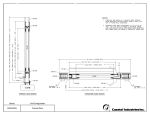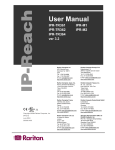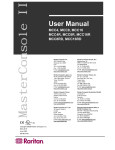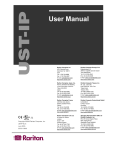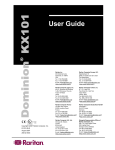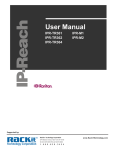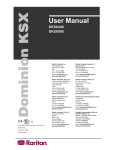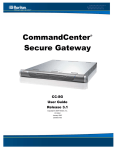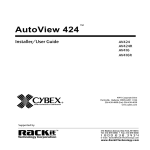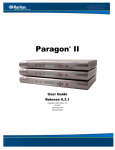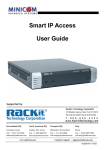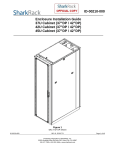Download Paragon II System Controller User
Transcript
User Guide V1.1 PSC-0A-E 255-30-6107 June 2005 Copyright © 2005 Raritan Computer, Inc. Raritan Computer Inc. 400 Cottontail Lane Somerset, NJ 08873 USA Tel. 1-732-764-8886 Fax. 1-732-764-8887 E-mail: [email protected] http://www.raritan.com/ Raritan Computer Europe, B.V. Eglantierbaan 16 2908 LV Capelle aan den IJssel The Netherlands Tel. 31-10-284-4040 Fax. 31-10-284-4049 E-mail: [email protected] http://www.raritan.com/ Raritan Computer Japan, Inc. 4th Flr. Shinkawa NS Building 1-26-2 Shin-kawa, Chuo-ku Tokyo 104-0033 Japan Tel. 81-03-3523-5991 Fax. 81-03-3523-5992 E-mail: [email protected] http://www.raritan.co.jp Raritan Computer Taiwan, Inc. 5F, 121, Lane 235, Pao-Chiao Rd., Hsin Tien Taipei Hsien Taiwan, ROC Tel. 886-2-8919-1333 Fax. 886-2-8919-1338 E-mail: [email protected] http://www.raritan.com.tw Raritan Computer France 120 Rue Jean Jaures 93200 Levallois-Perret France Tel. 33-14-756-2039 Fax. 33-14-756-2061 E-mail: [email protected] http://www.raritan.fr Raritan Computer Deutschland GmbH Lichstraße 2 D-45127 Essen Germany Tel. 49-201-747-9820 Fax. 49-201-747-9850 E-mail: [email protected] http://www.raritan.de Raritan Computer U.K. Ltd. 36 Great St. Helen's London EC3A 6AP United Kingdom Tel. 44-20-7614-7700 Fax. 44-20-7614-7701 E-mail: [email protected] http://www.raritan.com Shanghai Representative Office of Raritan Computer, Inc. RM 19C-1 Shanghai Shiye Building 18 Caoxi North Road Shanghai China 2000030 Tel. 86-21-64680475 Fax. 86-21-64627964 E-mail: [email protected] http://www.raritan.com.tw/ Supported by: ® Technology Corporation www.RackitTechnology.com Trademark Information Product names mentioned in this document are trademarks or registered trademarks of their respective companies. Paragon, Paragon II and CommandCenter and their logos are registered trademarks of Raritan Computer, Inc. Windows is a registered trademark or trademark of Microsoft Corporation in the United States and other countries. Sun and Java are registered trademarks of Sun Microsystems. All other marks are the property of their respective owners. System Requirements Your system must meet these minimum requirements in order to run the Paragon II System Controller Admin program: CPU: 1.5 GHz processor Memory: 256MB Operating System: Windows 2000 SP4 or Windows XP SP2 Other: Java Runtime Environment 1.4.2_03 or later (except version 1.5) For assistance in the U.S., please contact the Raritan Technical Support Team by telephone (732) 764-8886, by fax (732) 764-8887), or by e-mail [email protected] Ask for Technical Support – Monday through Friday, 8:00am to 8:00pm, EST. For assistance outside the U.S., please contact your regional Raritan office. This page intentionally left blank. CONTENTS I Contents Chapter 1: Installation and Configuration ................................................ 1 Installation ..................................................................................................................................1 Configuring the Paragon II System Controller ...........................................................................2 Further Configuration and Administration ..................................................................................4 Configure ...........................................................................................................................................5 View Status........................................................................................................................................6 Restart or Shutdown ..........................................................................................................................6 Diagnostics ........................................................................................................................................7 Adding the Paragon II System Controller to CommandCenter ..................................................8 Chapter 2: Paragon II System Controller Admin .................................... 13 Customize the System Controller Admin Window ...................................................................13 System Controller Admin Toolbar ....................................................................................................15 Multi Function View (MFV) Panel.............................................................................................16 Device Panel ............................................................................................................................17 Device View.....................................................................................................................................17 View by Channel.......................................................................................................................17 View by Type ............................................................................................................................18 Adding Paragon II Base UMTs to the System Controller .................................................................18 Channel Information Editor ..............................................................................................................19 Log Panel .................................................................................................................................20 Edit Event Log Settings ...................................................................................................................20 Power Strip Panel ....................................................................................................................21 Editing Power Strips and Power Outlets ..........................................................................................21 Power Strip Outlet Associations ......................................................................................................22 User Panel ...............................................................................................................................24 Create a User ..................................................................................................................................24 Delete a User...................................................................................................................................25 View User Properties .......................................................................................................................26 Save User Profile.............................................................................................................................26 Load User Profile .............................................................................................................................27 Disconnect and Exit System Controller Admin ........................................................................27 Appendix A: Configuring Attached IP-Reach and USTIP Units.............. 29 Appendix B: Device Backup and Restore............................................... 31 Backup a Paragon II System Controller:..................................................................................31 Restore a Paragon II System Controller: .................................................................................32 Appendix C: Upgrading Paragon II System Controller ........................... 33 Appendix D: FAQs.................................................................................... 35 FIGURES II Figures Figure 1 The Paragon II System Controller......................................................................................................1 Figure 2 Welcome Screen on First Launch ......................................................................................................2 Figure 3 Network Configuration Screen ...........................................................................................................2 Figure 4 PIISC Login Screen ...........................................................................................................................4 Figure 5 PIISC Main Menu...............................................................................................................................4 Figure 6 PIISC Network Configuration Screen.................................................................................................5 Figure 7 PIISC Status Screen ..........................................................................................................................6 Figure 8 PIISC Diagnostic Screen. ..................................................................................................................7 Figure 9 Add Device Selection Screen ............................................................................................................8 Figure 10 Add Device Screen for PIISC...........................................................................................................8 Figure 11 Launching the System Controller Admin..........................................................................................9 Figure 12 Paragon II System Controller Admin layout .....................................................................................9 Figure 13 Adding a base UMT in the Paragon System Configuration Window ..............................................10 Figure 14 Adding ports from a Paragon II system..........................................................................................11 Figure 15 PIISC Admin Window.....................................................................................................................13 Figure 16 View Menu (check marks indicates panels in view) .......................................................................13 Figure 17 MFV Displaying Channel Data .......................................................................................................16 Figure 18 MFV Displaying User Data.............................................................................................................16 Figure 19 Device Tree - View by Channel .....................................................................................................17 Figure 20 Device Tree - View by Type...........................................................................................................18 Figure 21 Paragon System Configuration window .........................................................................................18 Figure 22 Channel Information Editor ............................................................................................................19 Figure 23 Edit Log Settings Window ..............................................................................................................20 Figure 24 Power Strip View Window.............................................................................................................21 Figure 25 Power Strip Information Editor .......................................................................................................21 Figure 26 Outlet Information Window.............................................................................................................22 Figure 27 Associating a Device with a Power Outlet......................................................................................23 Figure 28 Add User Window ..........................................................................................................................24 Figure 29 Change Password Window............................................................................................................25 Figure 30 User Information Window...............................................................................................................26 Figure 31 Select Destination Path Window ....................................................................................................26 Figure 32 Confirm Load User Profile Window ................................................................................................27 Figure 33 Launching the Admin utility for an attached KVM over IP device ...................................................29 Figure 34 A list of KVM over IP devices used by the Paragon II System Controller.......................................29 Figure 35 The Admin screen for a selected KVM over IP Device ..................................................................30 Figure 36 Backup Device Screen...................................................................................................................31 Figure 37 Restore Device Screen ..................................................................................................................32 Figure 38 Upgrade Devices Screen ...............................................................................................................33 CHAPTER 1: INSTALLATION AND CONFIGURATION 1 Chapter 1: Installation and Configuration Installation Important! Each Paragon II System Controller can support up to eight (8) base UMTs. Additional UMTs will require additional PIISC units. Each unit must be on its own separate subnet. Figure 1 The Paragon II System Controller 1. 2. 3. 4. Attach the included AC power cord to the power port on the rear panel of the Paragon II System Controller (PIISC). Plug the other end or the cord into an AC power outlet. Connect a monitor, keyboard and mouse to the ports on the rear panel of the PIISC. Connect a standard Ethernet cable (included) from the network port to an Ethernet switch, hub or router. Power ON the PIISC unit and the connected monitor. 2 PARAGON II SYSTEM CONTROLLER Configuring the Paragon II System Controller The first time you boot a Paragon II System Controller, you will be greeted with the Welcome Screen. Figure 2 Welcome Screen on First Launch 1. Press <B> to start the Setup Wizard. The Network Configuration screen appears. Set the desired Network configuration parameters here using the <Tab>, [Ç], or [È] keys to select each line and the <Space>, [Å], or [Æ] keys to toggle between selectable values. Press the <Enter>, <Tab>, or [È] keys when your entry on each line is complete. Figure 3 Network Configuration Screen • Name: Designate a unique name for this System Controller unit, for example, “Miami Data Center.” • Enable Ethernet Interface: Designates whether PIISC should enable its Ethernet adapter (default: YES). - Line Speed & Duplex: Auto detect, 10 Mbps/Full Duplex, 10 Mbps/Half Duplex, 100 Mbps/Full Duplex, or 100 Mbps/Half Duplex - Obtain IP address automatically (DHCP): ♦ YES: Enables dynamic IP addressing for the Paragon II System Controller. Each time PIISC boots, it requests an IP address from the local DHCP server. Note that this setting can make adding a PIISC to CommandCenter difficult since the dynamically assigned IP address must be known to find it. ♦ NO (default): Assigns a fixed IP address to the Paragon II System Controller (recommended). IP Address: Enter the assigned IP address here. Subnet Mask: Enter the Subnet Mask for the PIISC. Default Gateway: Enter the Default Gateway for the PIISC if needed. CHAPTER 1: INSTALLATION AND CONFIGURATION 3 • 2. 3. Use Default TCP Port 5000: Designates whether PIISC should default to TCP Port 5000 (default: YES). Press <Ctrl+S> to save the changes on this screen and return to the Main Menu. You will be prompted to reboot the Paragon II System Controller. Reboot the PIISC from the Main Menu (see the section Further Configuration and Administration, Restart or Shutdown in this chapter). After you finish PIISC configuration and reboot, all of the information you have just entered is available to your CommandCenter unit. You can now add the PIISC as a Device in your CommandCenter application (see the section Adding Paragon II System Controller to CommandCenter in this chapter). 4 PARAGON II SYSTEM CONTROLLER Further Configuration and Administration Note: This section only applies if you are accessing the local admin interface for further PIISC configuration. 1. After rebooting or subsequent powering on of a Paragon II System Controller, you will be greeted by the PIISC login screen. Enter the default user name admin and the default password raritan then press <Enter>. Figure 4 PIISC Login Screen 2. When the Main Menu appears, you can use the [Ç] and [È] arrow keys or type the letter in brackets to highlight an option. The <Enter> key selects the highlighted option. Figure 5 PIISC Main Menu CHAPTER 1: INSTALLATION AND CONFIGURATION 5 Configure 1. 2. From the Main Menu, select Configure then press the <Enter> key. The PIISC Network Configuration Screen appears. Set the desired Network configuration parameters here using the <Tab>, [Ç], or [È] keys to select each line and the <Space>, [Å], or [Æ] keys to toggle between selectable values. Press the <Enter>, <Tab>, or [È] keys when your entry on each line is complete, or press <Esc> at any time to exit Network Configuration without saving changes. Figure 6 PIISC Network Configuration Screen • Name: Designate a unique name for this System Controller unit, for example, “Miami Data Center.” • Enable Ethernet Interface: Designates whether PIISC should enable its Ethernet adapter (default: YES). - Line Speed & Duplex: Auto detect, 10 Mbps/Full Duplex, 10 Mbps/Half Duplex, 100 Mbps/Full Duplex, or 100 Mbps/Half Duplex - Obtain IP address automatically (DHCP): ♦ YES: Enables dynamic IP addressing for the Paragon II System Controller. Each time PIISC boots, it requests an IP address from the local DHCP server. Note that this setting can make adding a PIISC to CommandCenter difficult since the dynamically assigned IP address must be known to find it. ♦ NO (default): Assigns a fixed IP address to the Paragon II System Controller (recommended). IP Address: Enter the assigned IP address here. Subnet Mask: Enter the Subnet Mask for the PIISC. Default Gateway: Enter the Default Gateway for the PIISC if needed. • 3. 4. Use Default TCP Port 5000: Designates whether PIISC should default to TCP Port 5000 (default: YES). Press <Ctrl+S> to save the changes on this screen and return to the main menu. You will be prompted to reboot the Paragon II System Controller. Reboot the PIISC from the Main Menu (see the section Restart or Shutdown below). Important: After configuring PIISC with this data and saving it, you MUST reboot the PIISC unit in order to save this data to the system. 6 PARAGON II SYSTEM CONTROLLER View Status To view the status of the PIISC unit and a list of events that have occurred such as new or changed ports, device restarts and other activities, use the View Status option on the PIISC Main Menu. 1. From the main menu, select the View status option using the [Ç] and [È] keys (or by pressing <V>) and press <Enter>. The Status screen appears: Figure 7 PIISC Status Screen 2. You can use the <T> and <B> keys to jump to the top and bottom of the event list respectively. If the event list spans multiple pages, press <N> to move to the next page and <P> to move to the previous one. When you are done, press <Esc> to return to the Main Menu. Restart or Shutdown 1. 2. From the main menu, select Restart or Shutdown using the [Ç] and [È] keys (or by pressing <R>) and press <Enter>. You are given the option to restart or shut down the Paragon II System Controller. Press <R> to restart the unit, <S> to shut it down or <Esc> to cancel and return to the Main Menu. CHAPTER 1: INSTALLATION AND CONFIGURATION 7 Diagnostics To perform network communications, ping devices, start or track a log and other diagnostics for the PIISC unit, log on to the PIISC. 1. From the main menu, select Diagnostics using the [Ç] and [È] keys (or by typing the letter <D>), and press <Enter>. The Diagnostic Console appears: Figure 8 PIISC Diagnostic Screen. 2. 3. Use the commands displayed on this screen to execute the diagnostics you want to perform. When finished, type the letter <X> and press <Enter> to return to the Main Menu. 8 PARAGON II SYSTEM CONTROLLER Adding the Paragon CommandCenter II System Controller to Once you have configured the Paragon II System Controller it can be added to CommandCenter. From there, you can add base-tier Paragon II UMTs, which will in turn add all tiered UMTs and auto discover UST-IP units and IP-Reach units with their associated user stations. You will be able to view and execute diagnostics and configuration commands on these devices, as well as access Paragon targets from within CommandCenter. 1. Launch and log on to CommandCenter as an Administrator. 2. Click on the Devices tab. 3. On the Devices menu, click Device Manager, and then click Add Device. The Add Device selection screen appears. Figure 9 Add Device Selection Screen 4. 5. Click on the Device Type drop-down arrow and select Paragon II System Controller. Click Next to proceed to the Add Device description screen. Figure 10 Add Device Screen for PIISC 6. 7. 8. 9. 10. Type the name of the PIISC unit in the Device Name field. Type a description for the PIISC in the Description field. Type the Device IP address as entered during configuration. Type admin in the Username field. Type raritan in the Password field. CHAPTER 1: INSTALLATION AND CONFIGURATION 9 11. Select a category and appropriate element from the Device Associations panel (please see the CommandCenter User Manual for more information on categories and elements). 12. Click OK to add the Paragon II System Controller. A Device Created Successfully message confirms that device has been added. 13. An icon representing your Paragon II System Controller unit appears in the Devices tree. Select the icon, right-click on it, and select Launch Admin from the shortcut menu. Figure 11 Launching the System Controller Admin 14. The System Controller Admin will launch, allowing you to add Paragon II Base UMTs to your Paragon II System Controller. Figure 12 Paragon II System Controller Admin layout 10 PARAGON II SYSTEM CONTROLLER 15. On the Setup menu, click Base UMTs. The Paragon System Configuration screen appears. Figure 13 Adding a base UMT in the Paragon System Configuration Window a. To add a new base UMT unit, click New. When the blank line appears in the table, click in the IP Address cell and type the IP address of the new base UMT unit. Press the TAB key on your keyboard to advance to the Port cell and type 3000 (the default value). The Status and Encryption Key cells will populate automatically. Click OK when finished to add the new base UMT unit to the table. b. To delete any existing base UMTs, select the row of the unit you want to remove and click Delete. When you are finished deleting UMTs, click OK. c. To close the Configuration window without saving any changes, click Cancel. 16. At this point you should name the devices connected to the added Paragon II units using the System Controller Admin (see Chapter 2: Paragon II System Controller Admin, Device Panel, Channel Information Editor). This will make it easier to identify target channels in the Configure Ports screen on CommandCenter. 17. Repeat steps 15 and 16 if you want to add more base-tier UMTs. Paragon II System Controller can accept up to 8 base UMTs, one at a time. 18. Exit the Paragon II System Controller Admin and return to CommandCenter. CHAPTER 1: INSTALLATION AND CONFIGURATION 11 19. In the CommandCenter Devices tree, select the Paragon II System Controller you just added. Rightclick on the icon and select Configure Ports from the shortcut menu. All available ports in the Paragon system you just added will be listed. Figure 14 Adding ports from a Paragon II system 20. Select the ports you want to add to the device tree by clicking on the corresponding checkboxes (or select all of them at once with Select All), then click OK. The selected ports now appear in the Devices tree as branches of the Paragon II System Controller and act as any other CommandCenter target (i.e. associations and user access permissions are handled by CommandCenter. See the CommandCenter User Guide for detailed instructions on managing targets). If you wish to add new ports to the Paragon II System Controller, or configure the attached Paragon II systems for local use, right-click on the PIISC device in the Devices tree, then select Launch Admin from the shortcut menu that appears. The Paragon II System Controller interface will launch in a new window. Please continue to Chapter 2: Operation in this manual to read more about how the Paragon II System Controller interface functions. 12 PARAGON II SYSTEM CONTROLLER CHAPTER 2: PARAGON II SYSTEM CONTROLLER ADMIN 13 Chapter 2: Paragon II System Controller Admin Customize the System Controller Admin Window The Paragon II System Controller Admin window contains the System Controller menu bar and tool bar, the Device panel, User panel, Log panel, and Power Strip View window. You can customize your view by resizing panels or by viewing or hiding any of these components (except for the Device panel). The Device panel displays all connected devices in your Paragon II system, and the User panel displays all users in your Paragon II system. The Log panel displays the current activity of the System Controller Admin. The Power Strip View panel displays any power strips configured in your Paragon configuration. When you launch the Paragon II System Controller Admin, the program downloads the databases of the added Paragon II units and populates the Device, User, and Power Strip panels. All data from the Paragon IIs are visible in the PIISC Admin window. Once a session is initiated, updates to the database happen in real time and changes to the Paragon database from other users are immediately reflected in your Paragon II System Controller Admin screen. Device Panel displays all connected devices in the Paragon II system Multi-Function View (MFV) Panel – displays device and/or user information Power Strip View Panel – displays power strips and connected ports Device View Tabs – view devices by Channel or by Type User Panel – displays users and groups in the system Log Panel – displays tracked events by date and time Figure 15 PIISC Admin Window Display or hide any of these panels, except for the Device panel, by selecting options on the View menu; click on the desired panels in the menu to view or to hide them. A check mark before the menu item indicates that it is in view. By default, the Device panel cannot be hidden. Figure 16 View Menu (check marks indicates panels in view) 14 PARAGON II SYSTEM CONTROLLER Resize the window panels by resting your mouse cursor on the border of two panels until a double-headed arrow appears. Click and drag the arrow to size the panel up/down or left/right. CHAPTER 2: PARAGON II SYSTEM CONTROLLER ADMIN 15 System Controller Admin Toolbar The System Controller Admin toolbar displays several most commonly used commands as shortcut buttons in order to save you time. Some of the menu commands and toolbar shortcuts are also available by rightclicking on a User, Device, or Channel icon and selecting a command from the shortcut menu that appears. Toolbar Shortcut Icons BUTTON COMMAND Add User: Adds a new user account in Paragon II System Controller Admin and the connected Paragon II system Delete User: Deletes the user selected in the User View window from Paragon II System Controller Admin and the connected Paragon II system View By Channel: Displays the devices in the Device panel by Channel View By Type: Displays the devices in the Device panel by Type Log File: Launches the Log Setting window for Administrators to configure event filters, event severity, and locations of saved log files 16 PARAGON II SYSTEM CONTROLLER Multi Function View (MFV) Panel The MFV panel of the screen displays detailed information of items you select in the Device panel, User panel, or Power Strip window and allows Administrators to edit item properties from this list. If you select a device in the Device tree, the MFV displays target-related information: name, device type, security group, and device status. If you select a user in the User tree, the MFV displays user-related information: user name, Admin status, security group, scan rate, and connection information. If you select a power strip outlet, the MFV displays outlet name and connected device type. Administrators can double-click on an entry in the MFV to activate the properties window for that entry, and modify data for devices, users, or outlets, as described in the respective sections of this chapter. Figure 17 MFV Displaying Channel Data Figure 18 MFV Displaying User Data CHAPTER 2: PARAGON II SYSTEM CONTROLLER ADMIN 17 Device Panel The Device panel displays all devices connected to the Paragon II units added to your Paragon II System Controller. To make control easier, you can view devices by Channel or by Type by selecting one of the two tabs at the base of the Device Panel. ICON INDICATES: Power Strip outlet – power off (CPU) Power Strip outlet – power on (CPU) Power Strip outlet – power off (PWR) Power Strip outlet – power on (PWR) Channel Available Channel Available with one power strip outlet association Channel Available with multiple power strip outlet associations Channel Disconnected Channel Disconnected with one power strip outlet association Channel Disconnected associations with multiple power strip outlet PC Occupied by a user PC Occupied by a user with one power strip outlet association PC Occupied by a user with multiple power strip outlet associations Power Strip Connected Device View View by Channel Click on the View by Channel tab to display devices in a hierarchical tree by channel. The icon at the top of the tree is the Paragon II System Controller in the configuration. Clicking on the + symbol next to this icon expands the tree to display all First Tier Paragon II devices that have been added to the system controller. Clicking on the + symbol next to a first tier device displays all devices connected to it, in port number order. Tiered switches appear as icons with the + symbol before them, and can also be expanded. Target servers appear as computer icons. Grey computer icons represent a target that is currently powered ON and blue computer icons represent a target that is powered ON and is currently occupied. Red computer icons represent a target that is currently off or disconnected. Figure 19 Device Tree - View by Channel 18 PARAGON II SYSTEM CONTROLLER View by Type Click on the View by Type tab to display devices in a hierarchical tree by device type. The three types of devices represented are Target Systems, Switches and Power Strips. A different symbol represents each type: Switches by a flat node, Target Devices by a grey computer and Power Strips by a lightening bolt. Clicking on the + symbol before each icon expands it to display all devices of that type in the configuration, displayed in alphabetical order. Figure 20 Device Tree - View by Type Adding Paragon II Base UMTs to the System Controller To add a Paragon II Base UMT to the device tree: 1. On the Setup menu, click Base UMTs. The Paragon System Configuration screen appears. Figure 21 Paragon System Configuration window 2. 3. 4. 5. To add a new base UMT unit, click New. When the blank line appears in the table, click in the IP Address cell and type the IP address of the new base UMT unit. Press the TAB key on your keyboard to advance to the Port cell. The default port is 3000. Status and Encryption Key populate automatically. Click OK to add the new base UMT unit to the table To delete any existing base UMTs, select the row of the unit you want to remove and click Delete. To close the PIISC Configuration window, click Cancel. Note: A maximum of 8 base UMTs can be added to the Paragon II System Controller. Base UMTs should be added one at a time. CHAPTER 2: PARAGON II SYSTEM CONTROLLER ADMIN 19 Channel Information Editor To view the properties or change the name of channel: 1. Select the target channel in the Device View window. 2. Right click on the highlighted channel and select Property. The Channel Information Editor appears. Figure 22 Channel Information Editor - Name: Give the device on this channel a name. Type: Select what type of device this is, CPU for target servers or any of the Raritan PowerStrips or non-Paragon switches available in the list. Depending on the Type selected, further information may be available in the window. - Status: Displays the current status of a target device on this channel - Security Group: The security groups the target device belongs to (This only affects local Paragon access from outside of CommandCenter). - Associated Outlets: Lists any power outlets associated with this target device. Select an outlet and click Remove to break an association. - Serial Number: Displays the serial number of a non CPU type device. 3. Click OK to save your changes when done, or Cancel to exit without saving. After saving the channel information, this device can be recognized by the given name in both the System Controller Admin and the CommandCenter Configure Ports screen 20 PARAGON II SYSTEM CONTROLLER Log Panel Edit Event Log Settings The Log panel located at the base of the Paragon II System Controller Admin window displays events that occur in your Paragon II system. As an Administrator, you can record and configure standard events and message filters, and set severity levels for events, color-coding them for easier identification. 1. On the Setup menu, click Log Setting. The Edit Log Setting window appears. Figure 23 Edit Log Settings Window 2. 3. 4. 5. 6. 7. Click on the + and – signs to expand and collapse the event tree in this window. Entries in the event tree are pre-determined events programmed into the System Controller Admin. Click on the check box before an event to select and specify that event for recording in the log panel. On the right side of the window, click on the Set Severity Level drop-down arrow and select a severity level for that event – levels are color-coordinated: high severity is represented by a red icon, medium severity is blue, and lowest severity is black. To restore the default levels for the events, click Restore. In the Log File Setting panel, the location for saved log files appears in the Select Log File field. The default location is C:/Documents and Settings/(username). To change the default location, click Browse and locate the folder in which you want to store log files. Click on the Size (MB) drop-down arrow to select the file size limit (default limit is 4MB). Once the log file hits the size limit set in this field, System Controller Admin automatically creates a new log file and continues to store events. Click OK to save the log settings, or click Cancel to close the window. CHAPTER 2: PARAGON II SYSTEM CONTROLLER ADMIN 21 Power Strip Panel The Power Strip panel is a mobile display of Raritan Remote Power Control Strips connected to your Paragon II system. Each node in the Power Strip tree represents a power strip, and you can click on the + and – signs to expand and collapse the view of devices plugged into each of the serially-controlled Power Strip outlets. If the Power Strip View panel is not visible, on the View menu, click Power Strip. Figure 24 Power Strip View Window The Paragon II System Controller Admin automatically detects Raritan Power Strips connected to any Paragon II system you add. Click on any Power Strip in the tree to view its outlets. Click on the + and – signs to expand and collapse the view. Right click on any Power Strip outlet to view its properties. Editing Power Strips and Power Outlets To organize the Power Strips in your Paragon II configuration and to keep track of the machines to which they are connected, you may want to name the Power Strips and outlets. 1. Right-click on any Power Strip icon and select Property to view its properties. The Power Strip Information Editor appears. Figure 25 Power Strip Information Editor 2. 3. 4. If needed, type a new name for the Power Strip in the Name field. Select the type of Power Strip under Type if the type displayed is not correct. Click OK to save the changes or click Cancel to close the window. 22 PARAGON II SYSTEM CONTROLLER 5. Expand the Power Strip tree and double-click on any Outlet icon to view its properties. The Outlet Information window appears. Figure 26 Outlet Information Window 6. 7. 8. 9. The name of the Power Strip it belongs to and the number of this Outlet appears in the Power Strip Name and Outlet fields. Type a name for the outlet in the Outlet Name field. Enter the Security Group settings in the Security Group field. Click OK to save the changes, or click Cancel to close the window. Note: Because the Power Strip cannot detect what device type is associated with a specific outlet through the power cables, outlet associations must be created manually before an outlet can indicate to what type of device it supplies power. Power Strip Outlet Associations You can assign specific devices to unassigned Power Strip Outlets from the System Controller Admin interface. 1. Ensure that the Power Strip View window is in view. Expand the Power Strip tree so you can see the outlet to which you plan to assign the selected device. 2. Click on a device in the Device panel and simply drag this device to the selected outlet icon. CHAPTER 2: PARAGON II SYSTEM CONTROLLER ADMIN 3. 23 When you release the device, you will be asked to confirm the association of the device to this specific outlet. Click Yes to complete the association or No to cancel it. Figure 27 Associating a Device with a Power Outlet 4. The device is now associated with that outlet, and you can control the power status from a local Paragon II user station, RRC, or CommandCenter. To dissociate power outlets from a device, see Channel Information Editor earlier in this chapter. Note: For devices with redundant power supplies, one device can be associated with up to four outlets 24 PARAGON II SYSTEM CONTROLLER User Panel The User panel displays users stored on the configured Paragon II systems and displays each user’s profile. Double-click on a user to display the User Information window. As Administrator, you can change account properties for users selected in this window. Note: User accounts and permissions for users accessing Paragon II via CommandCenter are handled within CommandCenter itself, as with any other device. Using the System Controller Admin to Add, Edit or Delete user accounts only affects those users accessing the Paragon II system through the local, analog user stations. ICON INDICATES: Admin logged in and Connected Admin logged in and Disconnected Admin logged out and Disconnected User logged in and Connected User logged in and Disconnected User logged out and Disconnected Create a User 1. On the Users menu, click Create. The Add User window appears. Figure 28 Add User Window 2. Type the new user’s name in the User Name field. CHAPTER 2: PARAGON II SYSTEM CONTROLLER ADMIN 3. 25 Click Change and the Change Password window appears. Type a new password in the Enter New Password field, then re-type the password in the Repeat Password field. Click OK when finished. Figure 29 Change Password Window 4. 5. 6. 7. 8. 9. 10. 11. 12. 13. The Security Groups field is automatically populated, based on the defaults of the Paragon II system to which you are connected. To change the assigned Security Groups, click Set Security Group and change the default groups (please consult your Paragon II User Guide for more information on Security Groups). Click on the Allow Administrator Privileges drop-down arrow and select an option from the list. In the User Options panel, click on the Scan Mode drop-down arrow and select the scan mode for this user. Global scan mode, the default, scans each channel for the same amount of time (default time = three seconds), and Individual scan mode scans each channel for a specified time you type in. To change the number of seconds for either type of scan, type the new duration of seconds in the Scan Time (Sec) field. Click on the Hot Key drop-down arrow and select a key from the list. When you press this key twice rapidly on any user station in your Paragon II configuration, the Paragon navigation window will appear. Note that this option is set in the Paragon II System Controller Admin, but is used anywhere in the Paragon II system. Click on the Previous Channel drop-down arrow and select a key from the list. When you press this key on any user station in your Paragon II configuration, the channel previously viewed will appear. Choose None to override this capability. Note that this option is set in the System Controller Admin, but is used anywhere in the Paragon II system. Click on the Green Mode (min) drop-down arrow and turn Green Mode (Powersave mode) Off or On. If you select On, type in the number of minutes after which, if there is no keyboard or mouse activity, the user station monitor goes blank. Click on the Help Display drop-down arrow to select how you want to view the Paragon help screen when activated from any user station in your Paragon II configuration. Help text can be active, scrolling across your screen from right to left, or it can be displayed in a single line. Click on the ID Display (sec) drop-down arrow to turn the ID display Off or On. If you select On, the ID Display will remain on the user station monitor for the number of seconds you type into the next field. In the Menu Position and ID Display Position panels, enter the Horizontal and Vertical placement of the menu on any of the user station monitors in your Paragon II configuration. Click OK when finished, or click Cancel to exit without adding a new user. Delete a User Deleting a user in the System Controller Admin deletes the user account from the System Controller screen and from the configured Paragon II system. 1. In the User panel, click on the user you want to delete. 2. On the Users menu, click Delete. A Confirm User Delete window appears. 3. Click Yes to delete the user or click No to close the window without deleting. Note: The Admin user cannot be deleted. 26 PARAGON II SYSTEM CONTROLLER View User Properties Administrators can modify user properties from the System Controller Admin interface as needed. 1. In the User panel, click on the user whose properties you want to modify. 2. On the Users menu, click Property. The User Information window appears. Figure 30 User Information Window 3. 4. Change any of the user’s properties, according to the guidelines just outlined in the section Create a User. When finished, click OK to change the user properties or click Cancel to close the window. Save User Profile As an Administrator, you can back up the User Database of the configured Paragon II system to your local computer using the Save Profiles command. 1. On the Users menu, click Save Profiles. The Select Destination Path window appears. Figure 31 Select Destination Path Window 2. Browse through the local system until you find the location where you want to save the User Profiles. Type the name of the file in the File Name field and click Save. A confirmation window will display the path to the folder and file you just chose. Click OK to close the window. CHAPTER 2: PARAGON II SYSTEM CONTROLLER ADMIN 27 Load User Profile Use the Load Profiles command to restore previously backed-up Paragon User profiles. 1. On the Users menu, click Load Profiles. The Confirm Load User Profile window appears. Figure 32 Confirm Load User Profile Window 2. Click Yes to load existing user profiles, or click No to exit the window. Note: If you load a user profile for a user that currently exists in the Paragon II system, the restored profile will replace the current profile. Important: The Load Profiles command can be used to restore previously saved Paragon Overview system database files (*.mxd files) from an older Paragon HW3 configuration. Disconnect and Exit System Controller Admin Close the browser window containing Paragon II System Controller Admin, to end the session and return you to CommandCenter. 28 PARAGON II SYSTEM CONTROLLER APPENDIX A: CONFIGURING ATTACHED IP-REACH AND USTIP UNITS 29 Appendix A: Configuring Attached IP-Reach and USTIP Units Raritan IP-Reach and UST-IP devices provide the Remote KVM access to CommandCenter from the Paragon II systems they are physically connected to. These devices should have been configured according to their User Guides. However, if they need to be reconfigured for some reason, this can easily be done through CommandCenter once the Paragon systems they are a part of have been added: 1. 2. Click on the Devices tab in Command Center. Right click on the Paragon II System Controller icon that represents the Paragon II system in question and select Remote User Station Admin. Figure 33 Launching the Admin utility for an attached KVM over IP device 3. CommandCenter will display a list of IP-Reach and UST-IP units that are providing KVM over IP access for the Paragon II system. Click the Launch Admin button next to the KVM over IP device you want to configure. Figure 34 A list of KVM over IP devices used by the Paragon II System Controller 30 PARAGON II SYSTEM CONTROLLER 4. A KVM window will appear and display the Configuration menu for the IP-Reach or UST-IP unit providing access. Figure 35 The Admin screen for a selected KVM over IP Device 5. Set the desired device configurations for this unit. Refer to your IP-Reach or UST-IP user guide for more specific instructions. APPENDIX B: DEVICE BACKUP AND RESTORE 31 Appendix B: Device Backup and Restore Like any other managed Raritan device, CommandCenter can backup and restore the device configuration of a Paragon II System Controller that has been added to the system. When this is done, it also backs up the device configuration and user configuration of the Paragon II systems it manages. Backup a Paragon II System Controller: 1. 2. 3. Click on the Devices tab in CommandCenter and select the PIISC unit you want to backup. On the Device menu, click Device Manager then Backup Device Configuration. The Backup Device Configuration screen appears. Figure 36 Backup Device Screen 4. 5. Enter a name and description for the backup file in the Backup Name and Description fields. Click OK to backup the Paragon II System Controller configuration to CommandCenter. 32 PARAGON II SYSTEM CONTROLLER Restore a Paragon II System Controller: 1. 2. 3. Click on the Devices tab in CommandCenter and select the PIISC unit you want to restore. On the Device menu, click Device Manager then Restore Device Configuration. The Backup Device Configuration screen appears. Figure 37 Restore Device Screen 4. 5. 6. Using the Backup Date dropdown menu, select the date of the backup you want to restore to. The corresponding name and description will appear in the Backup Name and Description fields for verification. Click OK. A confirmation dialog appears informing you that the Paragon II System Controller must be restarted after the restore. Click Yes to restore the configuration and restart the device or No to cancel without restoring. Note: The restore feature can only be used to restore a configuration to the device that generated the backup. It CANNOT be used to restore the device configuration from one Paragon II System Controller to another. APPENDIX C: UPGRADING PARAGON II SYSTEM CONTROLLER Appendix C: Controller Upgrading 33 Paragon II System CommandCenter can also update the firmware of your Paragon II System Controller and the Raritan devices it manages. This is performed the same way any other managed device is upgraded, and the firmware must be added to CommandCenter beforehand (see Chapter 5: Administration Tools, Firmware Manager in your CommandCenter manual for adding new firmware). 1. 2. Click on the Devices tab in CommandCenter, then select the Paragon II System Controller you want to upgrade. From the Devices menu, click Device Manager then Upgrade Device. The Upgrade Devices screen appears. Figure 38 Upgrade Devices Screen 3. Click on the Firmware Name drop down arrow and select firmware package you want to update your device to. Depending on the firmware package that was added to CommandCenter you may also see firmware updates for Paragon II, IP-Reach or UST-IP devices. Select these updates to upgrade the Paragon II, IP-Reach or UST-IP devices managed by the Paragon II System Controller. Note: Only base-tier UMT devices added to a PIISC can be updated through the CommandCenter. If the Paragon II system contains multiple tiers, we suggest removing the upper tiers and upgrading those Paragon units using the Paragon Update software. 4. 5. Click OK. A confirmation dialog appears informing you that the device must be restarted to complete the upgrade. Click Yes to upgrade the device and restart it, or No to cancel without upgrading. 34 PARAGON II SYSTEM CONTROLLER APPENDIX D: FAQS 35 Appendix D: FAQs QUESTION How do I add new users? How do I modify existing users? How can I view / modify target data? How do I edit switch properties? (Switches are a little different, since each switch will form an expandable node in a View By Channel window. Thus, if you double click on a switch there, you will expand the node and show a list of targets underneath.) How do I associate target servers with outlets? How do I configure the Events Filter? How do I resize / hide View panels? ANSWER On the User menu, click Create (or on the toolbar, click Create User). When the Add User window appears, type the new user name and new password and configure other options as needed. Click [OK] to save user. Double-click on the user icon in the User panel. When the User Properties window appears, modify the properties. Click [OK] to save changes. Select the View By Channel tab in the Device panel, expand the tree if necessary, and double-click on the target. When the Target Information window appears, modify the information as needed. Click [OK] to save changes. Select the View By Type tab in the Device panel, expand the tree if necessary, and double click on the switch. When the Switch Properties window appears, edit the switch name or model type from the pull-down list (these are the only editable fields). Click [OK] to save changes. Activate the Power Strip View window and expand the tree to view the power strip the device is connected to. When that power strip’s outlets appear, drag the icon representing the target server from the Device panel to the icon representing the outlet in the Power Strip View window. The outlet’s type will automatically reset to “CPU” and the outlet will be renamed to reflect the new target now associated with it. Please Note: Any single device can be associated with up to four power outlets. Once a device is associated with a power outlet, a small black power cord icon is placed next to its icon in the device view window. Devices with two or more associated outlets will show two power cord icons. On the Setup menu, click Log Settings. A node window appears. Each of the nodes represents a category of events the Paragon II system can report. Expand a node to display a list of specific alerts that fall under that category, each with its own checkbox. Click the checkboxes next to the events for which you want to receive notice and uncheck the events you do not want to see. The drop down list on the right of the window offers Administrators the ability to set severity levels for events. Select an event in the tree, and then select a severity level from the list. Severity is listed on a scale of 1-3. Under Log File Setting, configure the path of the log files being saved, and the maximum size of the log file. Once the log file’s max sized has been reached, PIISC Admin will create a new log file to continue the logging process. Click [OK] to save changes or click [Restore] to return PIISC Admin to its previous configuration. To resize View panels, hover your mouse cursor at the edge of that window until it becomes a double-pointed arrow. Drag up/down or 36 PARAGON II SYSTEM CONTROLLER QUESTION ANSWER left/right to resize the window. To hide panels, on the View menu, select the panel you want hidden. Unchecked windows are hidden from view. To view a panel again, on the View menu, select the panel you want to display. Please remember that you can hide only the User panel, Log panel, and Power Strip View window, and not the Device or the MFV panels. APPENDIX D: FAQS 37 38 255-30-6107 PARAGON II SYSTEM CONTROLLER












































